Key takeaways:
- Intercultural communication involves understanding cultural values, beliefs, and non-verbal cues, which can significantly vary between cultures.
- Effective intercultural communication fosters empathy, builds relationships, and enhances global collaboration, as seen in diverse personal experiences.
- Challenges include differing perceptions of time, language barriers, and misinterpretations of non-verbal signals, highlighting the need for clarity and awareness.
- Practical strategies for improvement include active listening, cultural education, and adaptability to navigate and appreciate diverse perspectives.

Understanding intercultural communication
Intercultural communication is more than just exchanging words; it’s about understanding the values, beliefs, and emotions that shape each culture. I remember my first experience speaking with a colleague from Japan; their indirect communication style was initially confusing to me. I found myself asking, why was it so hard for them to say ‘no’? It turned out that in their culture, maintaining harmony and respect took precedence over directness.
Another aspect of intercultural communication that often comes to heart is the role of non-verbal cues. I once attended a meeting where the Brazilian participants communicated through animated gestures and facial expressions, which felt warm and inviting. In that moment, I reflected on how our body language can create connections or barriers; it’s fascinating to consider how much can be conveyed without uttering a single word.
Have you ever felt misinterpreted because of cultural differences? I certainly have. During a trip to Germany, I was taken aback by how direct everyone was in their feedback. Initially, I felt exposed and even criticized. However, I came to appreciate this transparency as a form of respect. It’s these moments of discomfort that often lead to the most profound insights and growth in our understanding of each other.
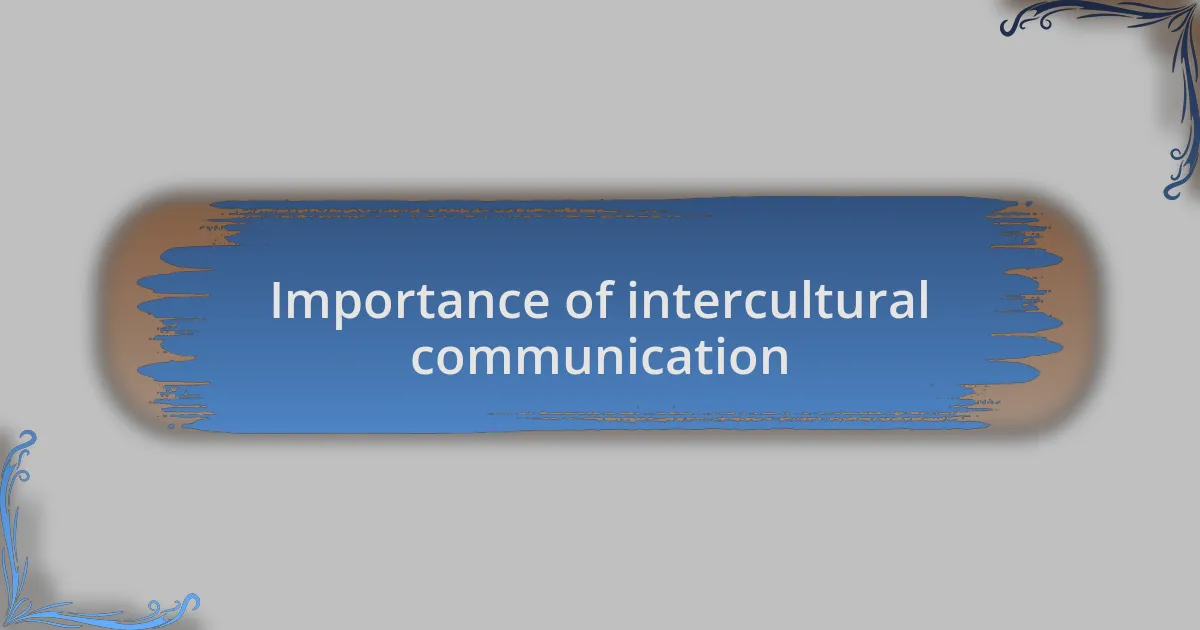
Importance of intercultural communication
Intercultural communication is crucial in our increasingly globalized world. I recall a tense business negotiation where miscommunication could have derailed a partnership. The different negotiation styles—my direct approach versus my partner’s more relational method—taught me that respecting and understanding these differences is essential for collaboration and success.
It’s amazing how effective intercultural communication can bridge gaps and build relationships. I remember volunteering with a diverse group of individuals from various backgrounds. Through open dialogues and shared experiences, we began to bond over our differences and similarities, which ultimately forged a stronger team spirit. Isn’t it interesting how, when we take the time to listen and learn, we can transform what could be misunderstandings into valuable connections?
Moreover, effective intercultural communication fosters empathy and broadens our worldview. After spending time working with refugees from Syria, I learned that their stories and struggles were rich with resilience and hope. This experience not only deepened my understanding of their cultural context but also made me reflect on my privilege and responsibility. How often do we pause to truly understand someone else’s path? It’s this journey of discovery that enriches our lives and enhances our ability to relate to others.
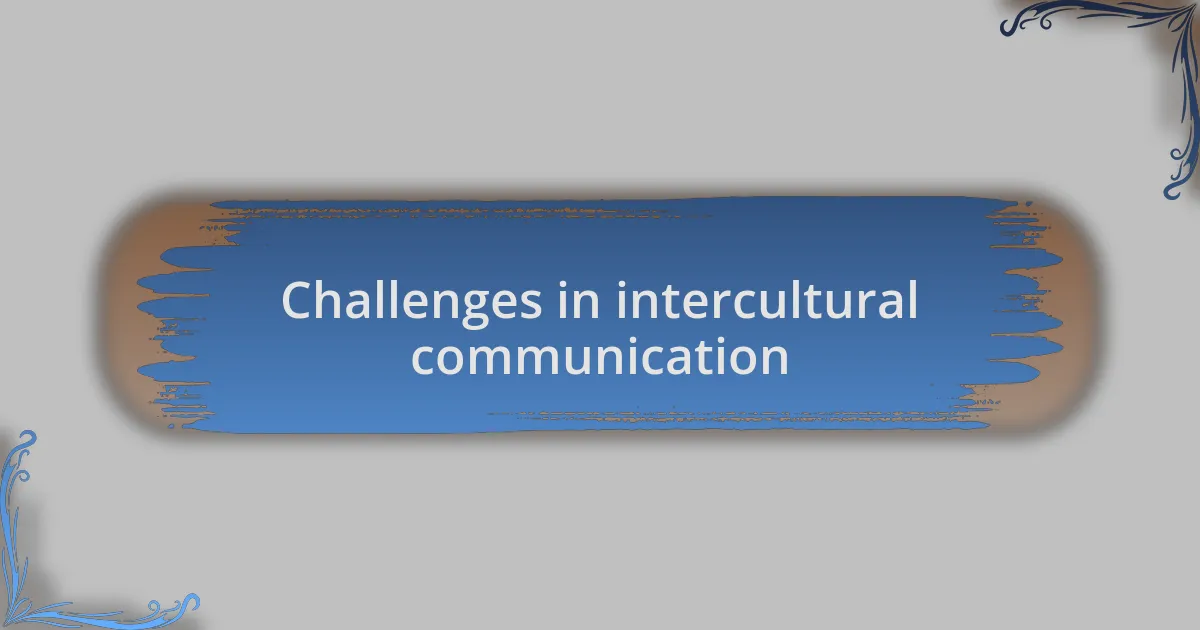
Challenges in intercultural communication
When engaging in intercultural communication, one significant challenge arises from differing nonverbal cues. I recall a conference where I misinterpreted a colleague’s crossed arms as defensiveness, only to later learn that it was a cultural indication of respect in their background. Reflecting on this experience made me realize how vital it is to familiarize ourselves with the nonverbal language of others—after all, what might seem like a closed-off gesture to me could signify something entirely different for someone else.
Another challenge I faced was the varied perceptions of time across cultures. I once partnered with a team that viewed deadlines as flexible rather than fixed. This led to frustration on my part, as I was accustomed to a more rigid approach. It taught me that understanding these differing perspectives can ease tensions and foster smoother collaborations. Have you ever felt the pressure of time slipping away while someone else seems perfectly at ease? That disparity can create confusion, but acknowledging these differences is crucial for effective communication.
Language barriers, too, pose significant obstacles, even among speakers of the same language. During a project with an international team, I found that idiomatic expressions often caused misunderstandings. For instance, I mentioned “hitting a wall” in relation to a project hurdle, which puzzled some team members unfamiliar with that phrase. This experience highlighted how essential it is to speak clearly and avoid jargon when communicating across cultures. How can we bridge such gaps if we don’t strive for clarity? Each conversation becomes an opportunity to refine our communication skills and build greater understanding.
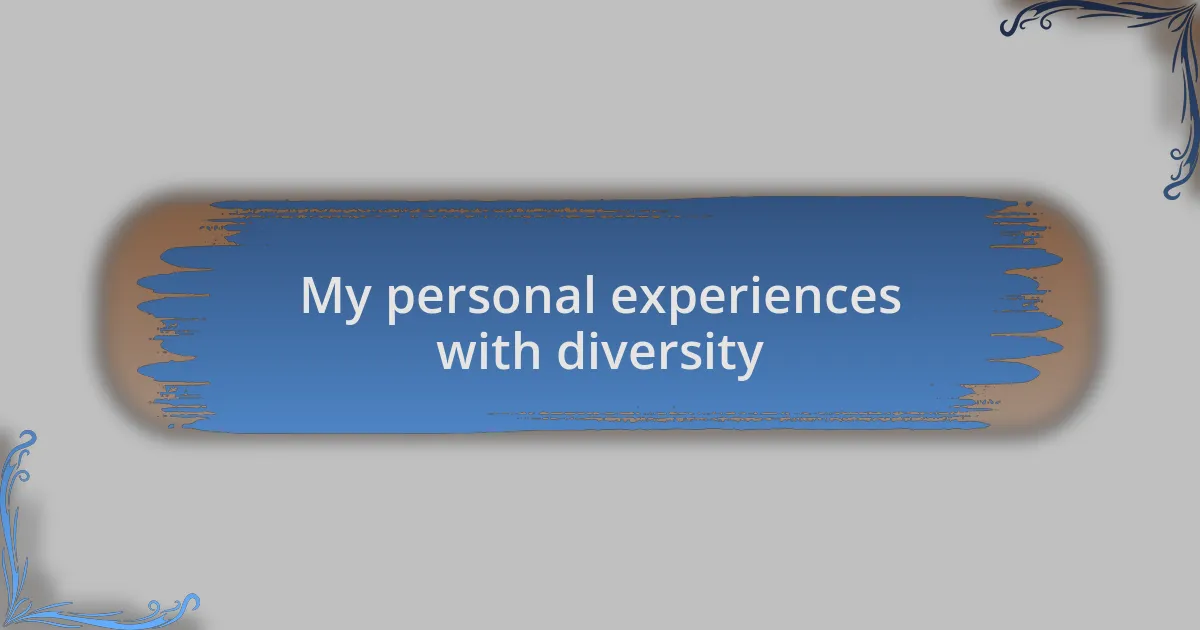
My personal experiences with diversity
Diversity has always surrounded me, but it wasn’t until I participated in a multicultural festival that I truly grasped its depth. I remember gazing at a stunning dance performance from a culture I had never encountered before. The colors, the rhythms, the laughter – it was a celebration that made me reflect on how diverse traditions enrich our lives. Have you ever witnessed something so beautiful that it opened your eyes to new perspectives? That experience left me eager to learn about the stories that shape different cultures.
During my college years, I worked on a group project with students from various countries. As we collaborated, I noticed how different backgrounds influenced our problem-solving approaches. One friend from Japan emphasized teamwork and harmony, while another from Brazil brought energy and spontaneity. I found myself feeling challenged yet invigorated by these contrasting styles. It made me question my own approach: Am I embracing diversity, or am I sticking to what feels comfortable? This realization has pushed me to step outside my comfort zone.
Additionally, I vividly recall a dinner with friends from several cultural backgrounds. As we shared meals from our respective cuisines, I became aware of the stories behind each dish. My heart swelled with connection as we swapped recipes and laughter, turning a simple meal into a beautiful mosaic of cultures. Doesn’t sharing food have a way of breaking down barriers and fostering community? In that moment, I discovered that every dish served not just sustenance but also shared history and belonging, reinforcing the incredible power of diversity in our lives.
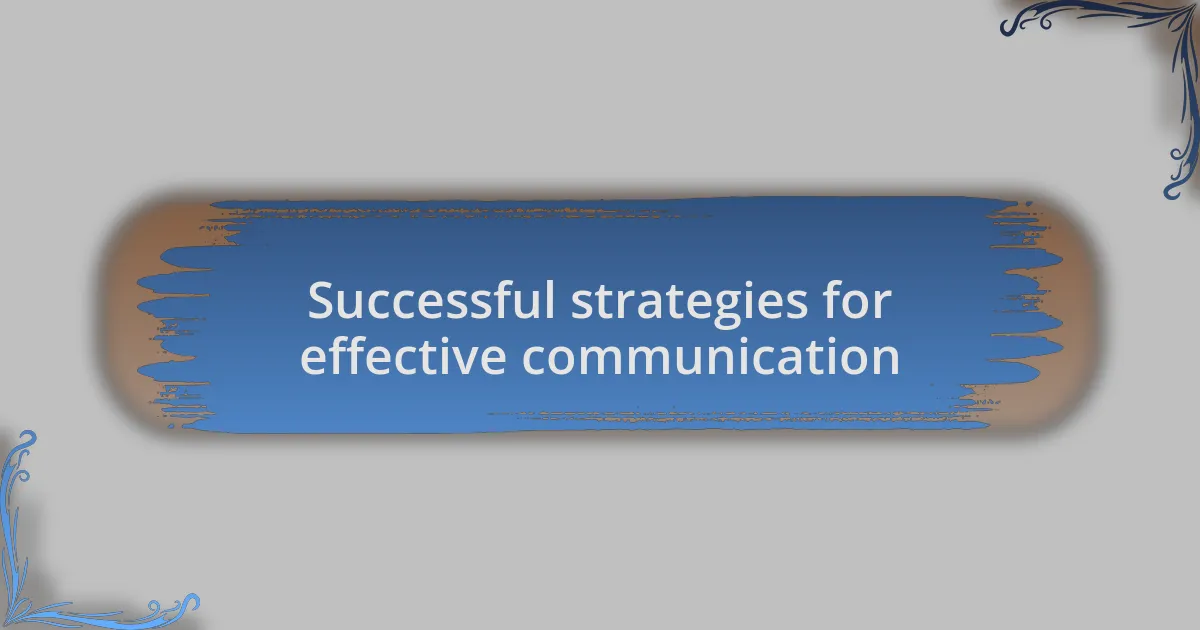
Successful strategies for effective communication
Successful communication across cultures requires active listening. I’ve discovered this while engaging in conversations where misunderstandings could arise due to language barriers. For example, during a business meeting with colleagues from different countries, I made it a point to ask clarifying questions, ensuring everyone was on the same page. Have you ever found that a little patience can go a long way? It’s amazing how much stronger relationships can grow through genuine effort to understand one another.
Emotional intelligence plays a crucial role in bridging cultural gaps. One time, while attending a cultural exchange, I noticed that gestures and expressions varied significantly among participants. In that moment, I learned to interpret non-verbal cues, which led to a deeper connection with others. Isn’t it fascinating how much can be conveyed with a mere smile or a thoughtful nod? By tuning into these subtle signals, we can navigate conversations with greater empathy and insight.
Lastly, adaptability is vital in effective intercultural communication. During my travels, I’ve had to adjust my approach depending on local customs and traditions. For instance, in some cultures, direct eye contact is a sign of respect, while in others, it’s considered rude. Reflecting on these experiences, I realize that being flexible not only helps in avoiding faux pas but also enriches my own understanding of different worldviews. How often do we overlook the need to adapt in our daily communications? Embracing this adaptability can truly enhance our interactions across cultures.
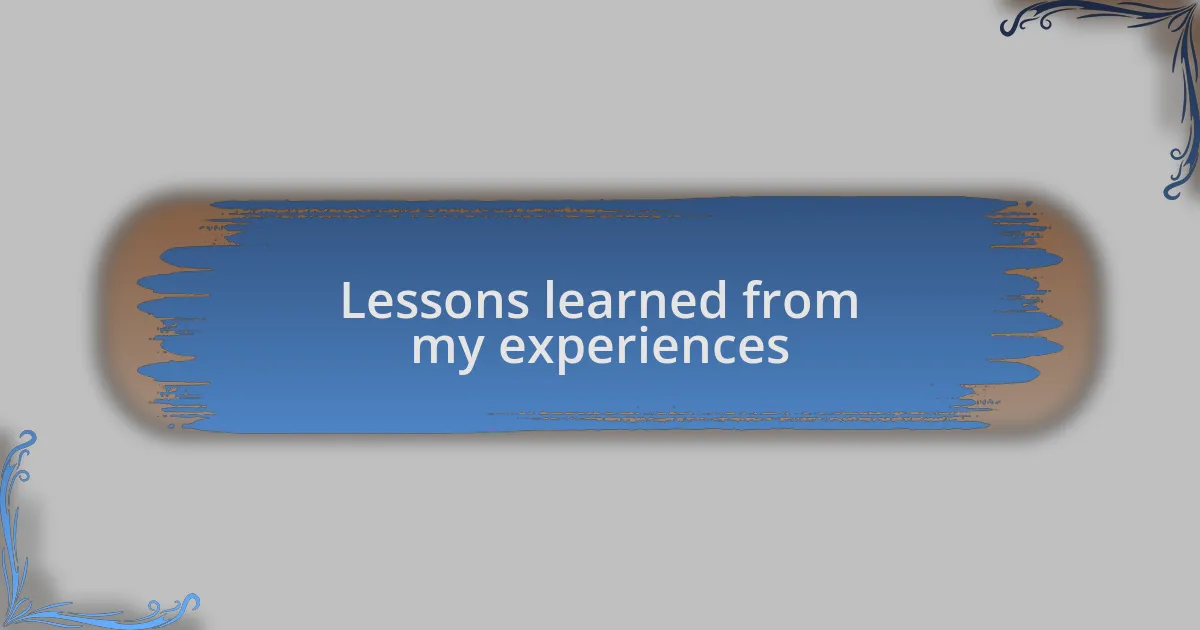
Lessons learned from my experiences
One of the most profound lessons I’ve learned is the importance of openness to new perspectives. I vividly remember a dinner I shared with a friend from Japan. Initially, I was unsure about how our cultural differences would affect our conversation, but that evening taught me to embrace differences. Instead of focusing on what set us apart, we found common ground, laughing over shared experiences. Have you ever noticed how a simple meal can break down barriers and create lasting connections?
Another key insight has been the significance of being aware of my biases. Engaging with people from diverse backgrounds forced me to confront my preconceived notions. I recall a workshop where participants were encouraged to share their stories. Listening to someone share their journey opened my eyes to experiences I had never considered. It made me reflect on my own life and question: how often do we let our biases shape our perceptions of others? This self-awareness has not only improved my communication skills but has also deepened my empathy.
Finally, I can’t stress enough the value of patience and a sense of humor. While volunteering in a multilingual community, I often found myself lost in translation, leading to some amusing moments. I vividly remember trying to explain a simple concept but ending up in a comedic verbal tangle. Instead of feeling frustrated, I laughed it off with my new friends, and that laughter became a bridge over our language gap. Isn’t it remarkable how humor can lighten the mood and foster friendship?

Tips for improving intercultural skills
When it comes to improving intercultural skills, one essential tip is to actively seek opportunities for genuine dialogue. I remember attending a cultural festival where participants were encouraged to share personal stories about their heritage. Engaging in these conversations not only expanded my understanding of different cultures but also made me realize how much we can learn from each other’s experiences. Have you ever found unexpected wisdom in someone else’s story?
Another valuable approach is to educate yourself about other cultures through various mediums. I often dive into literature and films from different countries, which helps me appreciate the nuances of their social norms and values. For instance, after reading a book from an author in Nigeria, I gained insights into communal living and the importance of family ties. Has a story ever changed the way you viewed a culture?
Lastly, practice active listening. I recall a conversation with a colleague from Brazil during a project meeting. Instead of formulating my response while they were speaking, I focused on truly understanding their perspective. This not only improved our collaboration but also formed a deeper respect between us. Isn’t it fascinating how listening can transform a simple interaction into a meaningful exchange?